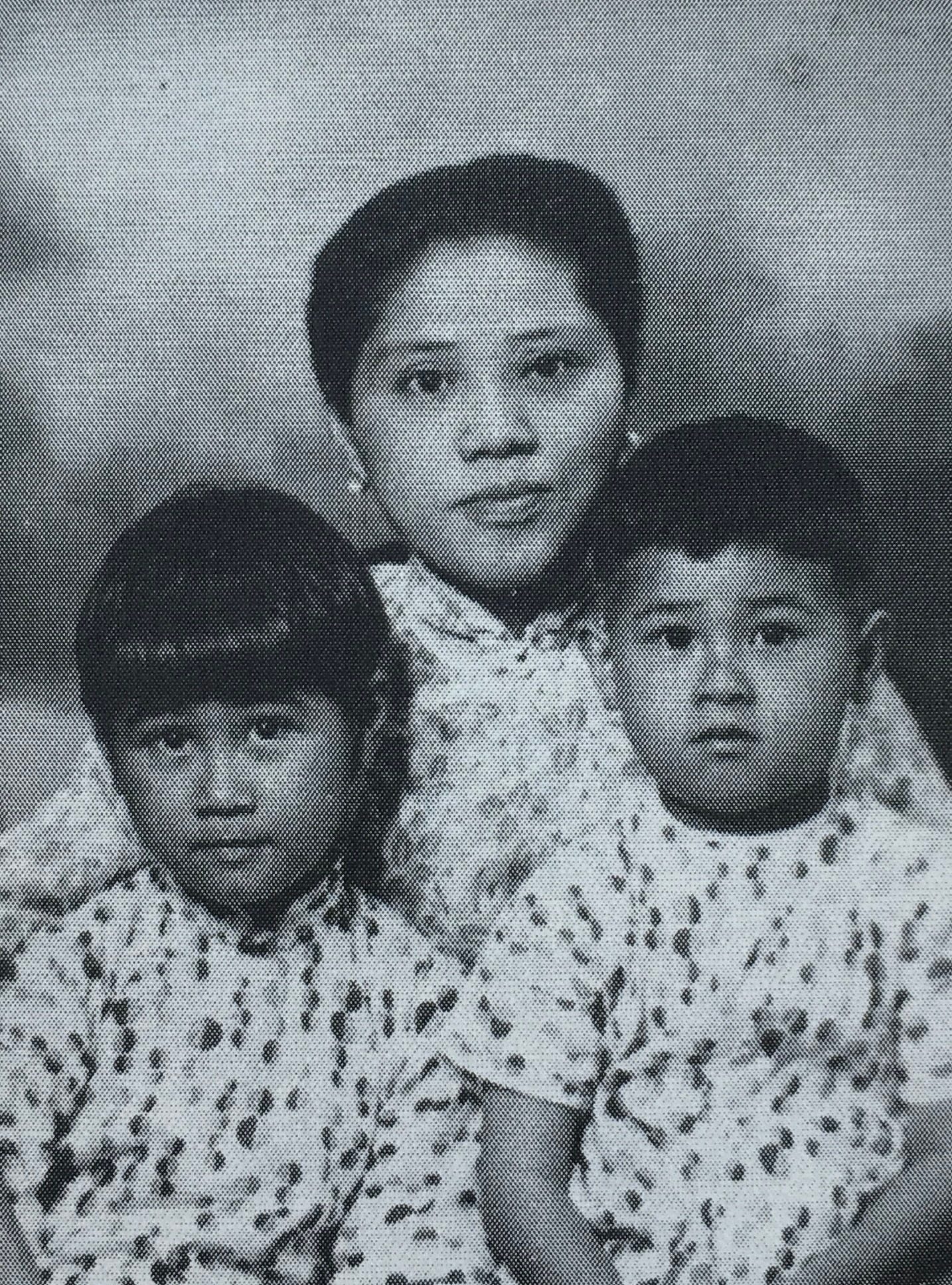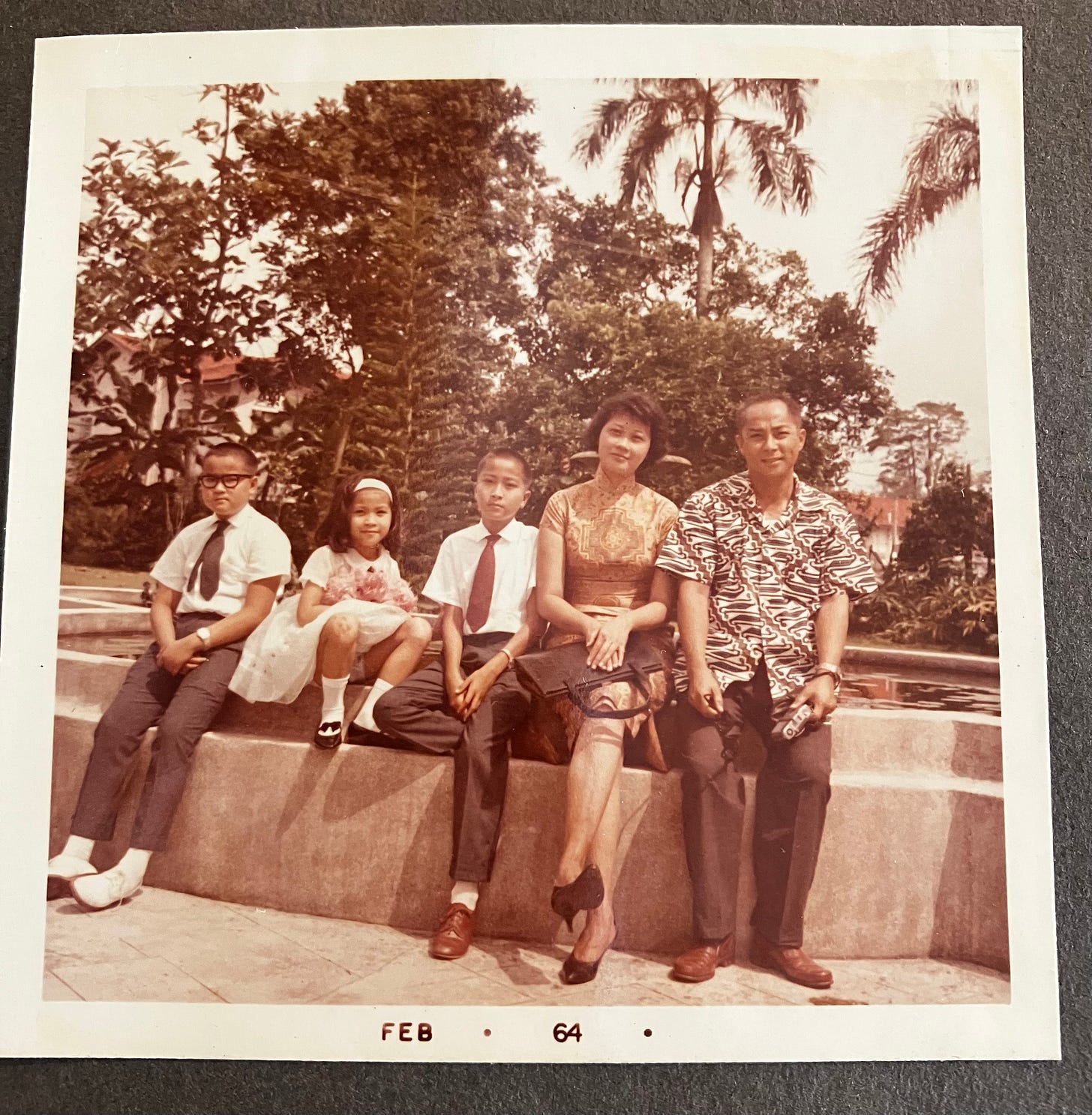My grandmother, Man Sheung ‘Trikkie’ Quek née Cheng, passed away on February 1, 2024 at the age of 98. She was my last remaining grandparent, and I was her last remaining grandchild. This evening, on a Monday afternoon on the other side of the world, her and my grandfather’s ashes were scattered in the Straits of Johor between their birth land Malaysia, and their beloved home, Singapore. You can watch her recorded ceremony here (I speak at 15:20) If you know me well, there’s a good chance I’ve told you about my grandmother. She lived a life that I’ve spent mine trying to understand and make meaning of - her journey across multiple countries and continents, the duality of a life coated in privilege yet punctuated by tragedy, and the sacrifices she made to devote herself to enriching the lives of others through art. I couldn’t be more proud to be her granddaughter.
Born in Kuala Lumpur, Malaysia in 1925 to a Chinese family, my grandmother Quek (née Cheng) Man Sheung a.k.a. ‘Trikkie’ was the third of five children and the only girl. She moved to Macau and then Hong Kong at the age of five, where she lived until 1941. Her father, Cheng Yun Tin, died in February 1941, shortly before Hong Kong fell under Japanese occupation during World War II. My grandmother spoke often of the horrors and suffering she’d seen during the occupation, and I know the experience impacted her deeply.

The Kwan family home on Kowloon was taken over by the Japanese Army and used as their headquarters and torture site. For her safety, my great-grandmother, Kwan Wai Hing ‘Daisy’, arranged for my 16-year-old grandmother to escape to China on a refugee boat with a group of missionaries. She spent years trekking through the countryside and mountains of China, staying between orphanages, schools, and with missionaries, not knowing if she would ever see her family again. Right before the war ended in 1945, she lost one of her older brothers, Cheng Man Kit, who was in the National Air Force.
Man Sheung ended up in Shanghai, where she finished secondary school and received a scholarship to study in the United States. She attended UC Berkeley before transferring to Earlham College, a small Quaker school in Indiana, where she could receive more support as she learned English. While at Earlham she was introduced to her roommate’s brother, who was studying at Butler University; he ended up being my late grandfather, Quek Kai Tong. They married in Washington D.C. and started a life together in my grandfather’s home country, Singapore. My grandmother’s education in the U.S. was something she was immensely proud of, and it greatly influenced her life and her dreams for her children.

My grandmother was an artist, an exquisite painter, and a deeply imaginative and creative person, who I think felt deeper than she knew how to express; thus, she turned to art. She made countless ink and watercolor paintings of flowers and landscapes and painted traditional Chinese watercolors on porcelain dishes and lamps. She started her business, Blue Ginger, to teach art classes to young people, and encouraged them to document the quickly fading scenes of old Singapore before it transformed into the modern metropolis it is known as today.
Blue Ginger evolved into a clothing line, and my grandmother worked with local artisans to create textiles in the style of traditional Indonesian batik. The designs were whimsical, colorful, and modern for their time. She opened shops throughout the city, with the most notable ones being at Raffles Hotel and the Shangri-La. Blue Ginger was considered to be one of the last remaining authentic Singaporean-made merchandise.
When I was young I was fascinated by her batik designs that my parents dressed me in as a child, and her paintings, which decorated the walls of my childhood home. Although she was sunsetting Blue Ginger by the time I was a child, I remember visiting her factory during a trip to Singapore. I watched, wide-eyed, as wax-stamped fabric was steeped in deep vats of dye, before being taken to the sewing room, where women cut and stitched the textiles into garments. Her last shop was at Raffles Hotel, and I recall wandering around the store, touching all the merchandise, as I waited for her to finish talking with her shopkeeper. After what felt like a long day (at least to an 8-year-old) she picked up warm tofu pudding, or douhua, for me to eat on the drive home.
When I was back at home in Seattle, inspired by her, I dreamed up ideas for clothes for my dolls and me, and my dad helped me mail my drawings to her. She considered my ideas seriously and made and sent the finished garments back across the Pacific to me. I recently converted a dress that I designed as an 8-year-old into a top - and it still fits!
As I got older, I asked her questions about her life and our family whenever I could. To many of these questions, she would answer, “not now…later!” or wave her hand dismissively and say, “Chinese family…very complicated!” as if that was the only explanation I needed. For as complicated as she believed our big Chinese family to be, her love for me always felt remarkably uncomplicated.
Everyone I know talks about how stubborn and headstrong my grandma was - until the very end of her life. But I was in the special position of being her granddaughter, and together we could be silly, playful, and sweet. When I picture her in my head, I see her winking at me with a mischievous smile.
My early adulthood was a time marked by a journey to connect with my full identity - to understand what it meant to be half Chinese, to feel like I was part of a big international family, and to accept my mixed identity. My grandmother always made me feel like I was enough just the way I was and helped me see myself, in her words, as a “bridge between the East and the West”, and embrace my mixed heritage.
I was fortunate to spend two weeks with her in Singapore last year. If you know me you know that I developed an intense phobia of flying after having a panic attack on a plane in 2019. It felt like a twisted joke that Singapore is at minimum an 18-hour flight from San Francisco, and it became a huge goal of mine to work through my fear so I could go - something that pretty much only my grandmother could motivate me to do. I’m so grateful for that time together, when we could be fully present - I knew there was a chance it would be my last time with her, and I treated all of our moments together as precious: eating dinner around the table, studying her art, looking at family photos, and even doing a little bit of watercolor painting. On my last night with her I started to cry, knowing that I had to say goodbye - maybe for the last time. She looked at me and told me it was alright, that I didn’t need to say anything, that she knew how much I cared about her, and that she would always be with me. And I knew she meant it.
She was a devout Christian, and joins her parents Cheng Yun Tin and Wai Hing, my late grandfather Kai Tong, her brothers Paul Man Dat, Man Kit, Man Chee, and Richmond Man Ching, her step-daughter and my half-aunt Rosalind Yuen Ning, her grandson and my beloved cousin Andrew Jia Ren, and her son-in-law and my Uncle Michael McGuire in heaven.
She is survived by her son and my father Timothy Yuen Teng and my mom Kimberly Sims, my Uncle Samuel Yuen Pao and my aunt Alice Chao, my aunt Angela Yuen Ping, and me, Natalie Jia Li.
She is so loved and I will miss her so much.





















